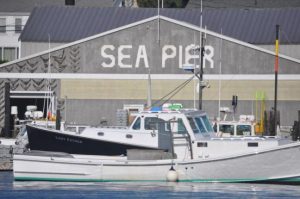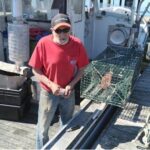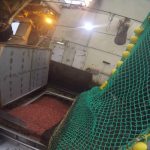Tag Archives: Atlantic Canada

Endangered right whale movements ‘totally different’ in Gulf of St. Lawrence in 2023
“What we saw this year was totally different compared to other years,” said Marcel Hebert of the Acadian Crabbers Association in Shippagan, N.B. “The North Atlantic right whale were found in very shallow waters, under 20 fathoms. It’s the first time we saw that since 2017 when we started to watch.” Their first appearance in the Gulf was a disastrous surprise for a species on the brink of extinction and the people who earn their living in those waters. Twenty of the whales died in the Gulf between 2017 and 2019. In Atlantic Canada, a single right whale detection closes a 2,100 square kilometre area of open water for 15 days and in the Gulf for the entire season if they keep showing up or stay. “Let’s be honest, this is hard for harvesters,” Gilchrist said. >click to read< 09:47

Crab ice cream, anyone? How we might be able to eat our way out of an invasive green crab problem
They’re tiny and they’re wreaking havoc on our coasts, but they also taste pretty good. European green crabs have posed a problem off the coast of Vancouver Island for decades now, and while current conservation efforts have focused on deep freezing them and throwing them in a landfill, some suggest eating them instead. The species, which is found across the Pacific Northwest is aggressive and feeds voraciously on shellfish; they have no natural predators, and they reproduce at a high rate. Each female can have up to 185,000 babies at a time. It’s not just a West Coast problem. Fisheries and Oceans Canada notes that the species, which originally came from Europe and North Africa and likely hitched a ride to North America on wooden ships in the early 19th century, first invaded east coast waters in the 1950s. >click to read< 09:50

Atlantic mackerel moratorium extended for 2023 season
Fisheries and Oceans Canada has extended the closure of Atlantic mackerel commercial and bait fishing in Atlantic Canada and Quebec for the 2023 season. In a notice to fish harvesters on Wednesday, the federal department said it was continuing the moratorium “to allow the stock to rebuild.” The moratorium has been in place since March 2022. In its notice, Fisheries and Oceans Canada said results of a Canadian stock assessment found Atlantic mackerel “declined further in the critical zone since the last assessment, with spawning stock biomass at its lowest-observed value.” The critical zone means serious harm is occurring. >click to read< 18:36

For Atlantic Canada, Fishing Season Brings Yet More Violence
In the early morning dark of April 12, 2023, violence erupted along a Nova Scotia riverbank after a man engaged a woman and a youth in a heated argument. Soon after, seven people arrived. One allegedly assaulted the man with a pipe while another stood nearby wielding a knife and a taser. When the RCMP later arrested two members of the group a short distance away, the officers found two shotguns and a taser. Conflict around elvers is not new, nor is it the only fishery in Atlantic Canada that’s seen so much turmoil. Whether it’s around elvers, lobsters, or something else, “this will continue to play out, and play out, and play out, until the government deals with the issues on the table.” >click to read< 08:05
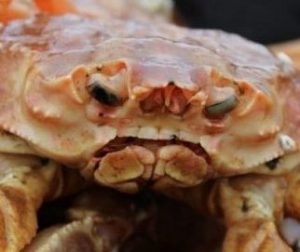
Fishers crabby over Japan’s Russian imports, but Tokyo says Canada exports negligible
Atlantic fishers are feeling the pinch as Japan brings in cheap Russian product rather than Canadian snow crabs, with federal ministers and provincial premiers saying they are raising the issue with Japanese officials. Snow crab prices have dropped in Newfoundland and Labrador from $7.60 per pound at the start of last year’s season to an opening price of $2.20 this year. Fishers in the province have refused to start harvesting this year as they scramble to sell off last year’s surplus, although the price could still rise. Meanwhile, Moscow has flooded other parts of the international market with cheap product. >click to read< 07:58

FFAW wants mackerel fishery re-opened
On Thursday, Mar. 30, 2022, the Department of Fisheries and Oceans Canada (DFO) issued a release announcing there would be no directed commercial or bait fishing for southern Gulf spring herring and the closure of the Atlantic mackerel commercial and bait fisheries in Atlantic Canada and Quebec. Now in 2023, Fish, Food, & Allied Workers (FFAW) is calling on the government to reopen the Atlantic mackerel fishery, stating that Newfoundland and Labrador communities shouldn’t bear the burden of this decision. “The biggest problem is that the fishery was closed when it should not have been,” said Courtney Glode, Communications Officer with FFAW. The U.S.A. announced in March that they will proceed with the commercial fishery in 2023, on the East Coast stock shared with Canada; however, an announcement on whether or not the moratorium will be lifted in Canada has not yet been made. >click to read< 10:07

‘The people’s fish’: Atlantic mackerel stocks have collapsed – can a moratorium bring them back?
Canada’s Atlantic mackerel population is a shadow of what it once was, and its decline threatens the well-being of the people who depend on it. Mackerel supports one of Atlantic Canada’s top recreational fisheries, and one of its oldest commercial fisheries. The fish is also used for bait, and it has an important place in Indigenous cultures. The same migratory stock supports recreational and commercial fisheries in the U.S. Last March, the federal Department of Fisheries and Oceans closed Canada’s commercial and bait mackerel fisheries for one year and placed daily personal limits on the recreational fishery, to give the population time to rebound. But the U.S. fishery remains open, albeit with a reduced quota. Next week, federal Fisheries Minister Joyce Murray will decide whether to reopen the Canadian fishery. The DFO’s latest studies have found no sign of recovery in the mackerel stock. Photos, >click to read< 13:09

Starvation price for snow crab fishermen
A week into the snow crab fishing season, processors in Quebec, New Brunswick and Nova Scotia on Friday agreed to a temporary dock price of $2.25/lb to $2.50/lb. “There’s more inventory on the market now than we thought, says Jean-Paul Gagne, Director General of the Quebec Fisheries Industry Association (AQIP). For his part, Marc-Olivier des Îles-de-la-Madeleine’s captain, Marco Turbide, promises to put his cages back this spring. “Expecting a price of only two or three dollars a pound doesn’t give ambition, he comments. It’s not fun. For a heavily indebted fisherman like me, we can’t expect to make a profit in 2023 because of the significant loss from crab last year. If we agree to $4/lb, I’m very I’ll be happy!” >click to read< 11:45

One shrimp stock off Labrador doing well but missed surveys means no new data for two other fishing zones
This news likely won’t come as a great surprise to most in Atlantic Canada’s shrimp fishing industry: scientists at the Department of Fisheries and Oceans (DFO) can’t provide a full assessment on two northern shrimp stocks on Canada’s east coast this year because they don’t have new data. In February DFO confirmed offshore trawl surveys in shrimp fishing areas (SFA) 5 and 6 could not be completed because a research ship was out of commission. In a technical briefing with media earlier Thursday, March 23, stock assessment biologist Nicolas LeCorre provided information mainly on SFA 4, the one zone where offshore trawl surveys were completed. >click to read< 08:04

Snow crab prices down by nearly 60 per cent in U.S. market
The snow crab season in Atlantic Canada usually doesn’t get going until mid-April, but that doesn’t mean fresh snow crab is not already hitting the U.S. market. Alaskan fleets finished up their tanner crab season this week. That crab is often marketed under the name “snow crab,” being of similar size and colour. If the Alaskan tanner fishery is a portent of things to come, snow crab catches this year will have much less value than in 2022. The tanner fishery started Jan. 15 with wharf prices at US$3.25 to US$3.35 per pound, according to the latest blog from U.S. seafood analyst Les Hodges. The initial offer from processors was $2.50 a pound, but that offer prompted a strike by the crab fishing fleet, that prompted a bump in the offer from processors. >click to read< 14:04

U.S. announces reduced East Coast commercial mackerel quota for 2023
The United States will proceed with a commercial fishery of the depleted East Coast mackerel stock it shares with Canada in 2023. The U.S. quota was released this week, putting pressure on Canada which has yet to decide whether it will continue a total moratorium it imposed in 2022 to help rebuild the population. The National Oceanic and Atmospheric Administration, the U.S. equivalent of the Fisheries and Oceans Canada (DFO), announced on Tuesday a total allowable catch of 3,639 metric tonnes. It was 27 per cent cut from 2022 in recognition that the transboundary stock remains in trouble and is overfished. >click to read< 19:01

N.L. snow crab sales to Japan displaced by Russia
While many countries are imposing sanctions on Russia as a result of the war in Ukraine, Japan is taking advantage of low Russian snow crab prices. Clifford Small, MP for Coast of Bays-Central-Notre Dame and federal fisheries critic, says that is preventing Newfoundland and Labrador processors from selling their crab to Japan, as they normally do. “To have one of our major markets dry up on us, and to dry up in a sense that basically they started buying from a country like Russia — that’s at war in Ukraine — flies in the face of what you’d expect from a great trading partner and an ally,” he said. >click to read< 15:44

Canadian Coast Guard can’t retire old fisheries science vessels on East Coast
Canada is extending the life of its two aging offshore fisheries science vessels on the East Coast as the Canadian Coast Guard struggles to bring their replacements into service. The transition has floundered because of breakdowns, unplanned maintenance and refits on both new and old fisheries science vessels. In response, Fisheries and Oceans Canada (DFO) has now postponed the planned retirement of 40-year-old CCGS Alfred Needler on Dec.31 and 34-year-old CCGS Teleost set for March 2023. >click to read< 09:18

Fall fish stock surveys won’t happen again
The Department of Fisheries and Oceans says 2022 will be another year without fish stock surveys, as it prioritizes transition work needed to replace older vessels in an aging fleet. The scientific surveys are used to assess the health of major fish stocks and are critical in determining quotas for commercial fisheries worth hundreds of millions of dollars in Atlantic Canada. Those inside the industry say DFO is falling short on their mandate and can’t make the most informed decisions on future quotas due to the limited data. >click to read< 07:33

Repeated Failures: DFO ship woes hampering East Coast science surveys
DFO has missed multiple surveys as it struggles to bring new offshore fishery science vessels into service, and aging ships near retirement. Sailing restrictions imposed early in the COVID-19 pandemic contributed to the problem, but so too have breakdowns on older ships and part replacements needed on the two new ships stationed on the East Coast. The science surveys are used to assess the health of major fish stocks and are critical in determining quotas for commercial fisheries worth hundreds of millions of dollars in Atlantic Canada. “There’s huge consequences. We want to know what’s going on. We need the data,” said Carey Bonnell, vice-president of sustainability and engagement at St. John’s-based Ocean Choice International, which is a seafood company. >click to read< 08:13

Ottawa earmarks $100 million for lost fishing gear, repair to harbours – $300-million fund for Atlantic Canada not enough, fishermen say
The federal government says $100 million from its hurricane Fiona fund will be earmarked for the recovery of lost fishing gear and the repair to small-craft harbours across Atlantic Canada and eastern Quebec. The federal Fisheries Department says in a news release the money will come from the $300 million Ottawa set aside for fishers, communities and companies affected by post-tropical storm Fiona, which made landfall on Sept. 24. >click to read< $300-million fund for Atlantic Canada not enough, fishermen say – Fishermen on P.E.I. say the federal government’s $300-million fund for Atlantic Canada is a good start to recover from post-tropical storm Fiona but falls far short of what is needed. It will cost millions just to fix the wharf at Covehead Harbour alone, said Allan Coady. >click to read< 09:26
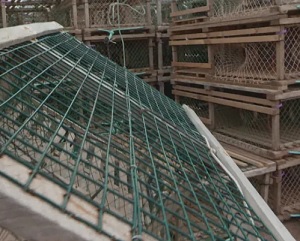
Atlantic Canada: Lobster fishery hoping for federal $$ to recover gear lost to Fiona
A plan is in the works to try to retrieve potentially thousands of lobster traps that were lost during post-tropical storm Fiona nearly two weeks ago. The storm, which battered Atlantic Canada with high winds and storm surges, resulted in tens of thousands of traps being damaged and lost in the Northumberland Strait, where fishermen in southeastern New Brunswick and northwestern Prince Edward Island are currently fishing. Luc LeBlanc, a fisheries adviser with the Maritime Fishermen’s Union, said while many traps have been recovered since the storm, “a few thousand” are still missing, and a plan is being worked out to find them and bring them ashore once the lobster season ends on Oct. 12. >click to read< 10:05
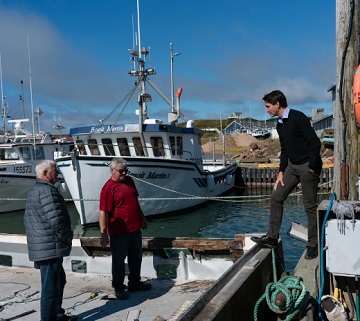
After Fiona’s wrath, Atlantic fishing communities look to rebuild livelihoods
All week, fishermen across Newfoundland, Prince Edward Island, Nova Scotia and New Brunswick were left to reckon with the damage left in Fiona’s wake, and to the region’s industry, which exports more than $4.5-billion worth of seafood each year. But as officials plan for the future, they face two competing priorities: the need to rebuild fast to be ready for the coming fishing season and the need to rethink infrastructure entirely in the face of climate change – a costlier, and potentially slower, approach. “PEI’s a mess. Newfoundland’s a mess. Nova Scotia’s a mess. And it’s all the same people who are fixing them,” said Leonard LeBlanc, President of the Gulf Nova Scotia Fishermen’s Coalition >click to read< 10:03
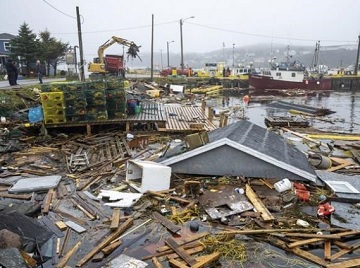
Newfoundland fishers face livelihood questions after Fiona storm damage
Colourful fishing stages bobbed in the water by Rose Blanche-Harbour Le Cou Tuesday as Cliff Bateman watched from his property. Days earlier, the picturesque buildings that are used to land and process fish were upright before post-tropical storm Fiona swept them into the ocean by the southwestern Newfoundland town. Bateman watched the storm toss them through the water. “It’s a big loss, I tell you that,” he said from inside his kitchen. The now-retired fisherman said he stored a priceless accumulation of gear and history inside the structures that were passed down through his family, some built over 100 years ago. >click to read< 10:08

Body found as Canada struggles to restore power after storm – ‘Everything is unusable’
Hundreds of thousands of people in Atlantic Canada remained without power Sunday and officials said they found the body of a woman swept into the sea after former Hurricane Fiona washed away houses, stripped off roofs and blocked roads across the country’s Atlantic provinces. After surging north from the Caribbean, Fiona came ashore before dawn Saturday as a post-tropical cyclone, battering Nova Scotia, Prince Edward Island, Newfoundland and Quebec with hurricane-strength winds, rains and waves. >click to read<
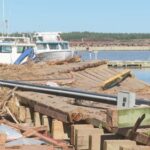 ‘Everything is unusable’: Fishers, farmers assess damage as Fiona wreaks havoc on industry – Officials have said areas exposed to storm surges have seen the most severe damage from the storm. In Morell, the Red Head Harbour wharf was almost completely totalled. Ken Drake was one of the fishers who spent Friday night there keeping an eye on their boats. He said all the boats have at least some damage. >click to read< 08:05
‘Everything is unusable’: Fishers, farmers assess damage as Fiona wreaks havoc on industry – Officials have said areas exposed to storm surges have seen the most severe damage from the storm. In Morell, the Red Head Harbour wharf was almost completely totalled. Ken Drake was one of the fishers who spent Friday night there keeping an eye on their boats. He said all the boats have at least some damage. >click to read< 08:05

Hundreds of thousands without power in Atlantic Canada as Fiona makes landfall
Hundreds of thousands of customers in eastern Canada are without power as post-tropical storm Fiona brings intense, hurricane-strength winds and torrential rains to swaths of Nova Scotia, Prince Edward Island, New Brunswick and Quebec’s Magdalen Islands. Fiona made landfall in Nova Scotia shortly after 4 a.m. AT between Canso and Guysborough. >click to read< – New Brunswick – While the eye of the storm is well east of the province, post-tropical storm Fiona is causing widespread power outages through much of New Brunswick. >click to read< – Prince Edward Island – Tens of thousands of Maritime Electric customers are without power in P.E.I. as Fiona passes through the region, with wind gusts hitting 150 km/h and almost 100 mm of rain down. >click to read< – Nova Scotia – Hundreds of thousands of customers in Eastern Canada are without power as post-tropical storm Fiona brings intense, hurricane-strength winds and torrential rains to swaths of Nova Scotia, Prince Edward Island, New Brunswick and Quebec’s Magdalen Islands. >click to read< – Newfoundland – Homes lost, residents flee as Hurricane Fiona approaches Newfoundland. >click to read< 08:40

Canadian Hurricane Centre says Hurricane Fiona will be ‘historic, extreme event’
The Canadian Hurricane Centre says Hurricane Fiona will make landfall in eastern Nova Scotia as a powerful post-tropical storm early Saturday. In a Friday afternoon briefing, Bob Robichaud, a warning preparedness meteorologist with the centre, cautioned people not to focus on the hurricane’s track since its effects will be felt across a swath of eastern Canada. Environment Canada says this includes much of Nova Scotia, P.E.I., southeastern New Brunswick, western and southwestern Newfoundland, and some parts of Quebec bordering the Gulf of St. Lawrence. >click to read< – Current Hurricane Conditions – Environment Canada (weather.gc.ca) 13:54

Hurricane Fiona threatens severe impacts across Atlantic Canada
Hurricane Fiona is roaring through the western Atlantic Ocean as a powerful Category 4 storm. The hurricane will brush Bermuda overnight Thursday before threatening major impacts across a large portion of Atlantic Canada. This is already a deadly hurricane. Five people died after Fiona produced devastating flooding across Puerto Rico as the storm traversed the Caribbean Island. Summer’s final sunset saw a powerhouse of a storm in Hurricane Fiona. The U.S. National Hurricane Center (NHC) found the storm had maximum sustained winds of 215 km/h on Wednesday evening. Some additional strengthening is forecast through Wednesday night, with some fluctuations in intensity possible on Thursday. Forecasters are keeping a close eye on potential impacts across Atlantic Canada for this weekend. Video, images, >click to read< 10:56

East Coast lobster harvest sustainable, according to non-profit’s criteria — but a Seafood Watch report advises consumers to avoid it
A recent report by a California-based seafood assessment group has the East Coast lobster industry seeing red. While Seafood Watch has put lobster on its “red list” and recommend consumers avoid it, lobster fisheries in most areas of Atlantic Canada have been certified sustainable by another group that has significant credentials in the business of seafood accreditation. In existence for about 25 years, the Marine Stewardship Council is a global non-profit organization that works to end overfishing around the world. Catherine Pigeon-Dubeau, fisheries and commercial manager for MSC in Eastern Canada, said the last review of the East Coast lobster fishery was in July of this year, and the Blue Label certification remains in place. >click to read< 14:10

Atlantic Canada snow crab sales slowed to a crawl in 2022 according to latest export data
In 2021 crab fishing crews landed just over 39,000 metric tonnes. With an average price of $7.36 per pound the landed value that season was $623 million. There were expectations that N.L. harvesters might land a billion dollars’ worth of crab in 2022, thanks to record high prices of $7.60 at the start of the season, and DFO’s decision to increase the overall quota by 32 percent. However, global financial uncertainty precipitated by the Russian invasion of Ukraine, the end of virus economic stimulus packages in the United States and rising interest rates, lead to consumers scratching high priced seafood from their grocery lists. Just over a month into the season snow crab prices plummeted. >click to read< 12:37

Atlantic fishing fleets ditch gill nets in favour of hook-and-line technology
The goal is higher-quality fish. That’s why one Canadian offshore fishing company is ditching gill nets in favour of hook-and-line fishing. The Arctic Fishery Alliance of Nunavut just bought a 52-metre longliner from Iceland to fish its quota of Greenland halibut (turbot) in the Davis Strait, near the Arctic Circle. In addition to adding modern processing equipment on board, the vessel will be fitted with a Mustad longline system, enabling the ship to deploy 40,000 fishing hooks daily. To fetch the best possible price in the market, a turbot fillet must be pure white. “And you don’t get that using gill nets,” said Earle. >click to read< 10:53

Regulations coming to Atlantic Canada could ensure safety of endangered right whales
Last month, Sierra Club Canada held a web discussion where it talked about the endangered North Atlantic right whale population in the Gulf of St. Lawrence and how new changes coming to the fishing industry could help protect them. DFO has been working to develop rope systems that are designed to release if too much force is applied suddenly. Currently, there are no regulations for fisherman to use low-bearing gear. Jenn Michael Lewis, who helps catch lobster in St. Peters Bay, said the response from fishermen in the community about the new rope regulations will likely be a negative one. “It has been a point of tension. There isn’t many right near St Peters Bay, many fishermen don’t see the point in switching,” Lewis said. >click to read< 08:10

Management Plan Released for Atlantic Herring in Southwest Nova Scotia and the Bay of Fundy
Atlantic herring is a vital species in Atlantic Canada. As one of the largest commercial fisheries in Atlantic Canada, the Southwest Nova Scotia / Bay of Fundy herring stock directly or indirectly employs more than 1,000 people in rural Nova Scotia and New Brunswick and contributes over $140 million to the local economy. Atlantic herring is also an important source of bait for other commercial fisheries, such as lobster and snow crab. Despite a number of measures taken in recent years to encourage rebuilding, the Southwest Nova Scotia / Bay of Fundy Atlantic herring stock remains in the critical zone. Stronger sustainable management actions are needed to protect this important species and return it to abundance. >click to read< 13:29

DFO: Atlantic Canada Grey Seal population is slowing
The grey seal population in Atlantic Canada continues to grow and is now estimated at 366,000, according to the 2021 stock assessment released Thursday by the Department of Fisheries and Oceans. But DFO says the population is growing at a much slower rate than in previous years and for the first time in 60 years it is believed pup production has decreased on Sable Island. Scientists used a new model to estimate the population in the latest report. It converted pup production numbers from aerial surveys to total population by combining reproductive and survival rates with the small number harvested by humans. Applying the new modelling to its 2016 estimate produced a sharply lower result. >click to read< 13:44

Snow crab prices plummet in Newfoundland
It wasn’t the news fish harvesters in Newfoundland and Labrador wanted to hear. They’ll get less for their snow crab after today, as the result of a decision by the province’s fish price setting panel. After reviewing a request from the Association of Seafood Producers and arguments by the Fish Food and Allied Workers, the panel went with the processors’ pitch of $6.15 per pound. That’s down nearly 20 per cent from the $7.60 per pound price that was set for the start of the season on April 1. In Nova Scotia, fish harvesters also saw a drop in snow crab prices a couple of weeks ago. They are now getting $8.25 a pound for snow crab, according to Gordon Beaton, local president with the Maritime Fishermen’s Union. >click to read< 11:06







































